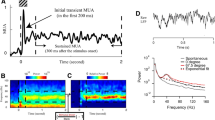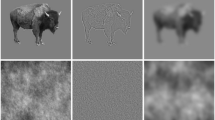Abstract
Visual presentation of an object produces firing patterns in cell assemblies representing the features of the object. Based on theoretical considerations and animal experiments, it has been suggested that the binding of neuronal representations of the various features is achieved through synchronization of the oscillatory firing patterns. The present study demonstrates that stimulus-induced gamma-band responses can be recorded non-invasively from human subjects attending to a single moving bar. This finding indicates the synchronization of oscillatory activity in a large group of cortical neurons. Gamma-band responses were not as apparent in the presence of two independently moving stimuli, suggesting that the neuronal activity patterns of different objects are not synchronized. These results open a new paradigm for investigating the mechanisms of feature binding and association building in relation to subjective perception.
Similar content being viewed by others
References
Bair W, Koch C, Newsome W, Britten K (1994) Power spectrum analysis of bursting cells in area MT in the behaving monkey. J Neurosci 14:2870–2892
Bauer R, Brosch M, Eckhorn R (1995) Different rules of spatial summation from beyond the receptive field for spike rates and oscillation amplitudes in cat visual cortex. Brain Res 669:291–297
Cacioppo JT (1990) The skelemotor system. In: Cacioppo JT, Tassinary LG (eds) Principles of psychophysiology. Cambridge University Press, Cambridge, pp 325–384
Eckhorn R, Bauer R, Jordan W, Brosch M, Kruse W, Munk M, Reitboeck HJ (1988) Coherent oscillations: a mechanism of feature linking in the visual cortex. Biol Cybern 60:121–130
Eckhorn R, Frien A, Bauer R, Woelbern T, Kehr H (1993) High frequency (60–90 Hz) oscillations in primary visual cortex of awake monkey. Neuroreport 4:243–246
Eckhorn R, Reitboeck HJ, Arndt M, Dicke P (1990) Feature linking via synchronization among distributed assemblies: simulations of results from cat visual cortex. Neural Computation 2:293–307
Engel AK, König P, Kreiter AK, Gray CM, Singer W (1991a) Temporal coding by coherent oscillations as a potential solution to the binding problem: physiological evidence. In: Schuster HG (ed) Nonlinear dynamics and neuronal networks. VHC, Weinheim, pp 3–25
Engel AK, König P, Kreiter AK, Singer W (1991b) Interhemispheric synchronization of oszillatory neuronal responses in cat visual cortex. Science 252:1177–1179
Engel AK, Kreiter AK, König P, Singer W (1991c) Synchronization of oscillatory neuronal responses between striate and extrastriate visual cortical areas of the cat. PNAS 88:9136–9140
Engel AK, König P, Kreiter AK, Schillen TB, Singer W (1992) Temporal coding in the visual cortex: new vistas on integration in the nervous system. Trends Neurosci 15:218–226
Gabor D (1946) Theory of communications. Proc IEE 93:429–457
Galambos R (1992) A comparison of certain gamma band (40-Hz) brain rhythms in cat and man. In: Basar E, Bullock TH (ed) Induced rhythms in the brain. Birkhäuser, Boston, pp 201–216
Gray CM, König P, Engel AK, Singer W (1989) Oscillatory responses in cat visual cortex exhibit inter-columnar synchronization which reflects global stimulus properties. Nature 338:334–337
Jokeit H, Makeig S (1994) Different event-related patterns of gamma-band power in brain waves of fast- and slow-reacting subjects. PNAS 91:6339–6343
Jürgens E, Rösler F, Henninghausen E, Heil M (1995) Stimulus-induced gamma oscillations: harmonics of alpha activity? Neuroreport 6:813–816
König P, Engel AK, Singer W (1995) Relation between oscillatory activity and long-range synchronization in cat visual cortex. PNAS 92:290–294
Kreiter AK (1992) Kodierung neuronaler Assemblies durch kohärente Aktivität: Korrelationsanalysen im Sehsystem von Säugetieren. Eberhard-Karls-Universität, Tübingen (PhD thesis)
Kreiter AK, Singer W (1992) Oscillatory neuronal responses in the visual cortex of the awake macaque monkey. Europ J Neurosci 4:369–375
Kreiter AK, Singer W (1994) Global stimulus arrangement determines synchronization of neuronal activity in the awake macaca monkey. Eur J Neurosci [Suppl] 7:153
Kristeva-Feige R, Feige B, Makeig S, Ross B, Elbert T (1993) Oscillatory brain activity during a motor task. Neuroreport 4:1291–1294
Lutzenberger W, Pulvermüller F, Elbert T, Birbaumer N (1995) Visual stimulation alters local 40-Hz responses in humans: an EEG-study. Neurosci Lett 183:39–42
Makeig S (1993) Auditory event-related dynamics of the EEG spectrum and effects of exposure to tones. Electroencephalogr Clin Neurophysiol 86:283–293
Milner PM (1974) A model for visual shape recognition. Psychol Rev 81:521–535
Neuenschwander S, Varela FJ (1993) Visually triggered neuronal oscillations in the pigeon: an autocorrelation study of tectal activity. Eur J Neurosci 5:870–881
Pantev C, Elbert T, Makeig S, Hampson S, Eulitz C, Hoke M (1993) Relationship of transient and steady-state auditory evoked fields. Electroencephalogr Clin Neurophysiol 88:389–396
Pantev C, Elbert T, Lütkenhöner B (eds) (1994) Oscillatory eventrelated brain dyamics. Plenum, New York
Pulvermüller F, Preissl H, Eulitz C, Pantev C, Lutzenberger W, Elbert T, Birbaumer N (1994a) Brain rhythms, cell assemblies and cognition: evidence from the processing of words and pseudowords. Psycoloquy 5:48
Pulvermüller F, Preissl H, Eulitz C, Pantev C, Lutzenberger W, Elbert T, Birbaumer N (1994b) Gamma-band responses reflect word/pseudoword processing. In: Pantev C, Elbert T, Lütkenhöner B (eds) Oscillatory event-related brain dymanics. Plenum, New York
Prechtl JC (1994) Visual motion induces synchronous oscillations in turtle visual cortex. PNAS 91:12467–12471
Priestley MB (1988) Non-linear and non-stationary time series analysis. Academic, London
Qian S, Chen D (1993) Discrete Gabor transform. IEEE Trans Signal Proc 41:2429–2438
Singer W, Gray CM (1995) Visual feature integration and the temporal correlation hypothesis. Annu Rev Neurosci 18:555–586
Tallon C, Bertrand O, Bouchet P, Pernier J (1995) Gamma-range activity evoked by coherent visual stimuli in humans. Eur J Neursci 7:1285–1291
Tiitinen H, Sinkkonen J, Reinikainen K, Alho K, Lavikainen J, Näätänen R (1993) Selective attention enhances the auditory 40-Hz transient response in humans. Nature 364:59–60
Tovee MJ, Rolls ET (1992) Oscillatory activity is not evident in the primate temporal visual cortex with static stimuli. Neuroreport 3:369–372
Malsburg C von der, Schneider W (1986) A neural cocktail-party processor. Biol Cybern 54:29–40
Young MP, Tanaka K, Yamane S (1992) On oscillating neuronal responses in the visual cortex of the monkey. J Neurophysiol 67:1464–1474
Zeki S (1993) A vision of the brain. Blackwell Scientific, London
Author information
Authors and Affiliations
Rights and permissions
About this article
Cite this article
Müller, M.M., Bosch, J., Elbert, T. et al. Visually induced gamma-band responses in human electroencephalographic activity — a link to animal studies. Exp Brain Res 112, 96–102 (1996). https://doi.org/10.1007/BF00227182
Received:
Accepted:
Issue Date:
DOI: https://doi.org/10.1007/BF00227182




